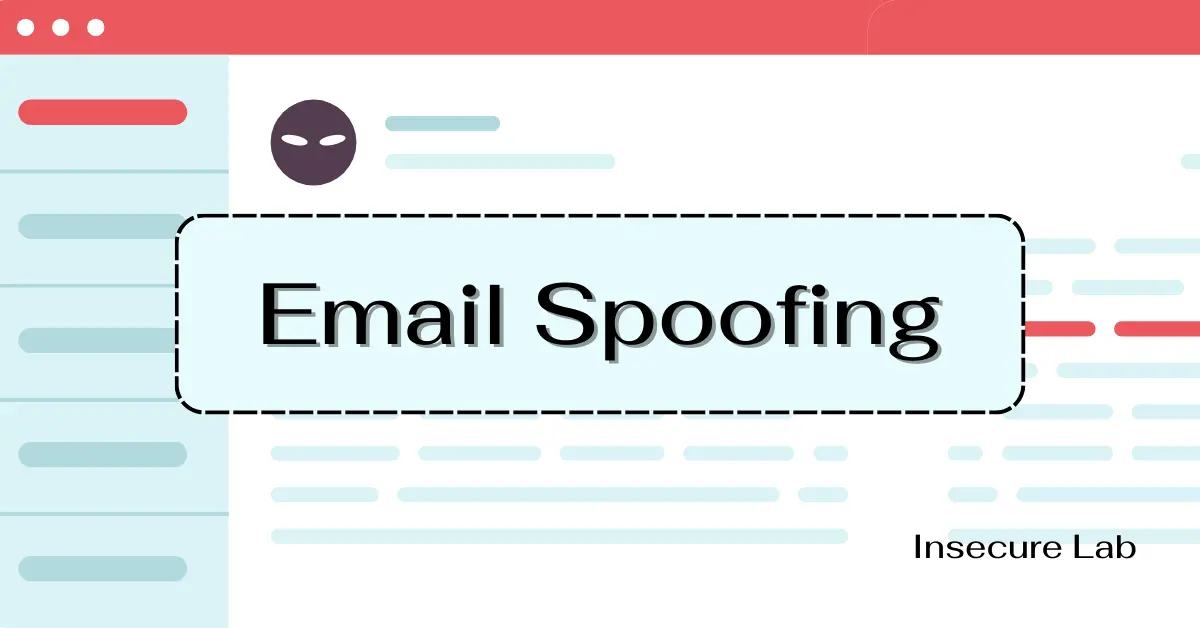🔍 Search
📥 Subscribe
Email Spoofing

Table of Contents
This ethical hacking guide covers email spoofing, attack detection with analysis of spoofed email address header example and its prevention in cyber security.
What is Email Spoofing?
Email spoofing is a technique used by malicious actors to send an email with a spoofed sender address to trick the recipient into appearing as if it is coming from a legitimate source.
This deception is mainly used in phishing attacks and spam emails, the purpose of which is to steal sensitive information, spread malware, or commit fraud.
How does Email Spoofing Work?
Email protocols (SMTP, POP, and IMAP) lack the mechanism to authenticate the sender's identity, making it surprisingly easy to alter email headers. A spoofed email involves modification in the 'From', 'Reply-To', and 'Return-Path' fields of the email header.
Here's a step-by-step process explaining how an attacker might spoof an email address:
1. Choosing the Target
The attacker decides whom they want to impersonate and collects the email addresses of potential victims. The target could be an individual or an organization.
2. Setting Up a Sending Email Server
The attacker sets up an email server or uses an existing one that allows the modification of outgoing email headers. Some attackers also use scripts or SMTP (Simple Mail Transfer Protocol) tools that facilitate email spoofing.
3. Forging Email Headers
The attacker crafts the email headers. Email headers are pieces of metadata sent with emails that include information like the sender, recipient, date, and subject. In an email spoofing attack, the "From" header is forged to display the email address the attacker wants to impersonate.
- "From" Header: This is where the attacker puts the email address they are impersonating.
- "Reply-To" Header (optional): Sometimes, the attacker sets a "Reply-To" header different from the "From" address, so any replies to the spoofed email go to an address controlled by the attacker.
4. Composing the Email
The attacker composes an email that appears legitimate. This might include mimicking the writing style of the person being impersonated, using the organization's logo, or including links to malicious websites.
5. Sending the Email
Using the configured email server or tool, the attacker sends the forged email to the target. The email appears to come from the spoofed address.
6. Recipient's Perception
The recipient sees the email, which appears to be from a trusted source, and may be more likely to open it, click on links, or provide sensitive information.
Example of a Spoofed Email
Scenario
An attacker wants to impersonate a bank (let's call it "Example Bank") to trick a user into revealing their login information.
Sample Email
Dear Valued Customer,
We have noticed some unusual activity on your account and need to verify your identity.
Please click the link below to confirm your account information.
[Malicious Link]
Failure to verify your account within 24 hours will result in your account being suspended.
Thank you,
Customer Support Team
Example Bank
Sample Email Header
An email header contains detailed information about the path an email has taken, including the sender, recipient, and the servers it passed through.
Here's a simplified example of what an email header might look like in a spoofed email:
Return-Path: <[email protected]>
Received: from maliciousdomain.com (maliciousdomain.com. [192.0.2.123])
by mx.google.com with ESMTPS id n123si12345678qkb.123.2023.12.19.08.00.00
for <[email protected]>
(version=TLS1_2 cipher=ECDHE-RSA-AES128-GCM-SHA256 bits=128/128);
Mon, 19 Dec 2023 08:00:00 -0800 (PST)
DKIM-Signature: v=1; a=rsa-sha256; c=relaxed/relaxed;
d=maliciousdomain.com; s=google;
h=mime-version:date:message-id:subject:from:to;
bh=4YzgA2L/0DjIYgXLWJH9Gm7NQqOpP9RtBjvXz90A4yI=;
b=HyQf3...[Truncated]...
Received-SPF: pass (google.com: domain of [email protected] designates 192.0.2.123 as permitted sender) client-ip=192.0.2.123;
Authentication-Results: mx.google.com;
dkim=pass [email protected];
spf=pass (google.com: domain of [email protected] designates 192.0.2.123 as permitted sender) [email protected]
MIME-Version: 1.0
X-Received: by 2002:a1f:9d05:: with SMTP id x5mr12345678vkb.123.1608307200987;
Mon, 19 Dec 2023 08:00:00 -0800 (PST)
Date: Mon, 19 Dec 2023 08:00:00 -0800
Message-ID: <[email protected]>
Subject: Urgent Account Verification Required
From: Example Bank <[email protected]>
To: [email protected]
Content-Type: text/plain; charset="UTF-8"
Email Header Analysis
Key Points to Note in the Spoofed Header
- Return-Path:
This is different from the "From" address.
It shows the actual sender's email address (
[email protected]), which is different from the displayed sender's address ([email protected]). - Received:
The IP address and domain in the 'Received' line (
maliciousdomain.com [192.0.2.123]) don't match the legitimate domain of the supposed sender. - DKIM-Signature & SPF:
These might still pass if the spoofer has set up their domain correctly, but it's important to note the domain (
maliciousdomain.com) mentioned here.
Prevention Methods
Preventing email spoofing requires a multi-layered approach that combines technical measures and user awareness. Here are several effective mitigation strategies:
1. Email Authentication Protocols
Utilize email authentication protocols like SPF (Sender Policy Framework), DKIM (DomainKeys Identified Mail), and DMARC (Domain-based Message Authentication, Reporting, and Conformance). These protocols verify the authenticity of the sender's domain and help prevent unauthorized use of email addresses associated with your domain.
2. Email Filters and Anti-Spam Solutions
Utilize robust email filtering and anti-spam solutions to detect and block spoofed emails before they reach the recipient's inbox. These solutions employ advanced algorithms and threat intelligence to identify suspicious or fraudulent emails, minimizing the risk of successful spoofing attacks.
3. User Education and Incident Response
Train users to recognize and report phishing attempts. Have a clear and efficient incident response plan for dealing with email spoofing attacks and related security breaches.
